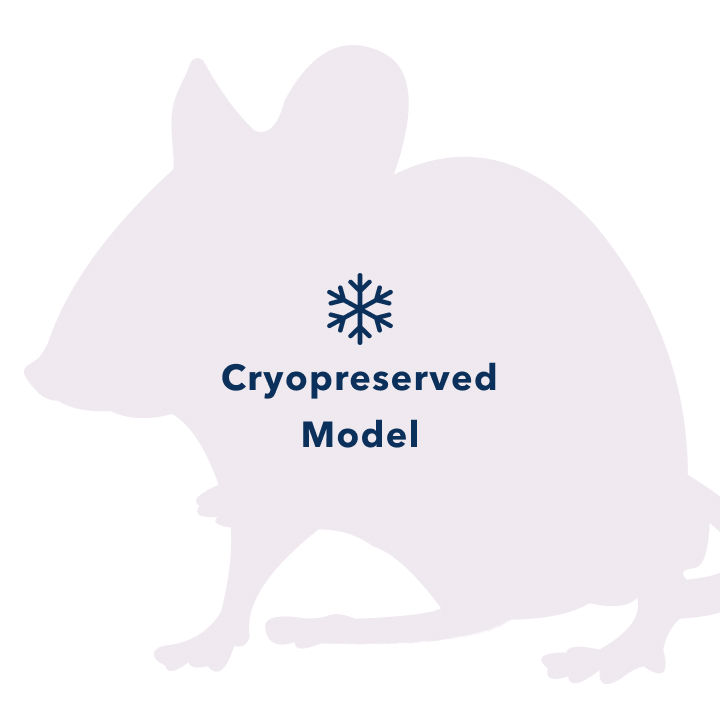| Model No. | Nomenclature | Genotype |
|---|---|---|
| 1487-F | FVB.129P2-Abcb1atm1BorAbcb1btm1Bor N12 | ko/ko;ko/ko |
| 1487-M | FVB.129P2-Abcb1atm1BorAbcb1btm1Bor N12 | ko/ko;ko/ko |
Mdr1a/b

- Description
- Related Products & Services
- Price & Licensing
- Health Report
- Overview
- Genetics
- Guides & Publications
- Applications & Therapeutic Areas
- Transit, Housing & Welfare
- Diet
Overview
Nomenclature: FVB.129P2-Abcb1atm1BorAbcb1btm1Bor N12
- Carries a disruption of multi-drug resistance genes Abcb1a (ATP-binding cassette, sub-family B (MDR/TAP), member 1A, a.k.a. Mdr1a) and Abcb1b (ATP-binding cassette, sub-family B (MDR/TAP), member 1B, a.k.a Mdr1b) encoding p-glycoprotein 3 and p-glycoprotein 1, respectively
- Mdr1a protein is normally expressed actively in the intestine and at the blood-brain and blood-testis barriers
- Mdr1b protein is normally highly expressed in the adrenal gland, pregnant uterus and ovaries
- These p-glycoproteins actively extrude a wide range of drugs from cells and can confer multi-drug resistance to tumor cells
- Lack the protective function of p-glycoproteins and exhibits a functional deficiency in the blood-brain barrier
- Useful in a wide range of central nervous system research including neurotoxicology, drug transport, oral bioavailability and multi-drug resistance studies
Recommended Controls
The recommended control for this model is FVB/NTac.
Origin
The Mdr1a/b mouse was developed in the laboratory of Alfred Schinkel of the Netherlands Cancer Institute. The model was created through sequential targeting of the Abcb1a and Abcb1b genes in E14 ES cells. Resultant chimeras were backcrossed to FVB/N for seven (N7) generations. Taconic received stock in August 1997. The mice were then backcrossed five more generations (N12) to FVB/N. The colony is maintained by mating doubly homozygous mice.
Genetics
Guides & Publications
Initial Publication:
Schinkel AH, Mayer U, Wagenaar E, Mol CA, van Deemter L, Smit JJ, van der Valk MA, Voordouw AC, Spits H, van Tellingen O, Zijlmans JM, Fibbe WE, Borst P. (1997) Normal viability and altered pharmacokinetics in mice lacking mdr1-type (drug-transporting) P-glycoproteins. Proc Natl Acad Sci USA, 94(8):4028-4033.
Applications & Therapeutic Areas
- ADMET
- Inflammation
- Microbiome
- Neuroscience
- Safety Assessment
- Immunology
Transit, Housing & Welfare
Need more info? Click the live chat button or Contact Us
1487 males are packed as cagemates, without recombination of animals from different cages into a single Taconic Transit Cage (TTC). We recommend that customers do NOT recombine 1487 males from different Taconic Transit Cages into the same cage at or after unpacking.
Packing Practices
Taconic standard practice is to recombine animals of different home cages and/or ages from a single model and sex during packing, except in specific cases where Taconic's animal welfare policy prohibits recombination due to aggression or other concerns. When an order is fulfilled with animals from more than one week of birth, this standard practice results in animals from a range of birth weeks packed together in a single TTC. When an order is fulfilled with animals from genotyped models, this standard practice results in animals from different home cages packed together in a single TTC.
Customers who wish to keep animals from different weeks of birth separated should place orders with the special instruction "Divide and label by age." Note that this special request can result in increased costs for additional Taconic Transit Cages, dividers and/or freight charges.
Taconic discourages other types of custom packing requests as they can have a negative impact on animal welfare. Learn more.
Diet
- Services
- Licensing
- Pricing - USD
- Pricing - EUR
- Pricing - DKK
- Pricing - USD Nonprofit
- Pricing - EUR Nonprofit
- Pricing - DKK Nonprofit
- Select my Health Standard
- Get Custom Pricing Guide
Mdr1a/b
Conditions of Use for Taconic Transgenic Models™
Taconic Transgenic Models™ (Models) are produced and distributed under rights to patents and intellectual property licensed from various institutions. Taconic sells the Models to purchasers, grants to each purchaser a right under Taconic's rights in such licensed patents and intellectual property to use the purchased Model in consideration of purchasers' acknowledgement of and agreement to the Terms and Conditions for Taconic Models, Products and Services and the following terms of use:
- Title to these Models and biological materials derived from them remains with Taconic.
- The Models will be used for research purposes only.
- The Models will not be bred or cross-bred except to obtain embryos or fetuses required for research purposes unless additional rights have been granted in writing by Taconic.
- The Models and biological materials derived from them will not be distributed to third parties or used for commercial purposes.
- Non-profit purchasers may not use this Model and/or biological materials derived from it in sponsored research or contract research studies unless it is purchased at the for-profit price.
Pricing - USD
Murine Pathogen Free (MPF) Health Standard
1487 Female
1487-F Genotype ko/ko;ko/ko
Pilot-sized cohorts are readily available. Large cohort requests have a minimum 8-week lead time. An estimated lead time will be provided to you within 2-3 business days.
| Age in Weeks | Quantity 1 - 999 |
|---|---|
| 3 to 10 | US$396.00 |
1487 Male
1487-M Genotype ko/ko;ko/ko
Cohorts are reserved upon order placement and will take 2-4 weeks to fulfill. An estimated lead time will be provided to you within 2-3 business days.
| Age in Weeks | Quantity 1 - 999 |
|---|---|
| 3 to 10 | US$396.00 |
Pricing - EUR
Murine Pathogen Free (MPF) Health Standard
1487 Female
1487-F Genotype ko/ko;ko/ko
Pilot-sized cohorts are readily available. Large cohort requests have a minimum 8-week lead time. An estimated lead time will be provided to you within 2-3 business days.
| Age in Weeks | Quantity 1 - 999 |
|---|---|
| 3 to 10 | 360,00 € |
1487 Male
1487-M Genotype ko/ko;ko/ko
Cohorts are reserved upon order placement and will take 2-4 weeks to fulfill. An estimated lead time will be provided to you within 2-3 business days.
| Age in Weeks | Quantity 1 - 999 |
|---|---|
| 3 to 10 | 360,00 € |
Pricing - DKK
Murine Pathogen Free (MPF) Health Standard
1487 Female
1487-F Genotype ko/ko;ko/ko
Pilot-sized cohorts are readily available. Large cohort requests have a minimum 8-week lead time. An estimated lead time will be provided to you within 2-3 business days.
| Age in Weeks | Quantity 1 - 999 |
|---|---|
| 3 to 10 | kr.2.678,00 |
1487 Male
1487-M Genotype ko/ko;ko/ko
Cohorts are reserved upon order placement and will take 2-4 weeks to fulfill. An estimated lead time will be provided to you within 2-3 business days.
| Age in Weeks | Quantity 1 - 999 |
|---|---|
| 3 to 10 | kr.2.678,00 |
Pricing - USD Nonprofit
Murine Pathogen Free (MPF) Health Standard
1487 Female
1487-F Genotype ko/ko;ko/ko
Pilot-sized cohorts are readily available. Large cohort requests have a minimum 8-week lead time. An estimated lead time will be provided to you within 2-3 business days.
| Age in Weeks | Quantity 1 - 999 |
|---|---|
| 3 to 10 | US$396.00 |
1487 Male
1487-M Genotype ko/ko;ko/ko
Cohorts are reserved upon order placement and will take 2-4 weeks to fulfill. An estimated lead time will be provided to you within 2-3 business days.
| Age in Weeks | Quantity 1 - 999 |
|---|---|
| 3 to 10 | US$396.00 |
Pricing - EUR Nonprofit
Murine Pathogen Free (MPF) Health Standard
1487 Female
1487-F Genotype ko/ko;ko/ko
Pilot-sized cohorts are readily available. Large cohort requests have a minimum 8-week lead time. An estimated lead time will be provided to you within 2-3 business days.
| Age in Weeks | Quantity 1 - 999 |
|---|---|
| 3 to 10 | 360,00 € |
1487 Male
1487-M Genotype ko/ko;ko/ko
Cohorts are reserved upon order placement and will take 2-4 weeks to fulfill. An estimated lead time will be provided to you within 2-3 business days.
| Age in Weeks | Quantity 1 - 999 |
|---|---|
| 3 to 10 | 360,00 € |
Pricing - DKK Nonprofit
Murine Pathogen Free (MPF) Health Standard
1487 Female
1487-F Genotype ko/ko;ko/ko
Pilot-sized cohorts are readily available. Large cohort requests have a minimum 8-week lead time. An estimated lead time will be provided to you within 2-3 business days.
| Age in Weeks | Quantity 1 - 999 |
|---|---|
| 3 to 10 | kr.2.678,00 |
1487 Male
1487-M Genotype ko/ko;ko/ko
Cohorts are reserved upon order placement and will take 2-4 weeks to fulfill. An estimated lead time will be provided to you within 2-3 business days.
| Age in Weeks | Quantity 1 - 999 |
|---|---|
| 3 to 10 | kr.2.678,00 |
Select my Health Standard
Need help choosing the right Taconic Biosciences health standard for your research?
Use the Health Standard Selector to enter your exclusion list. The tool will tell you which health standards meet your requirements.
Get custom pricing guide
Schedule A Scientific Consultation
Connect directly with a member of our Scientific Solutions team who can help you select the most appropriate model and maximize your experimental success.
















.jpg)

.jpg)
.jpg)
.jpg)
.jpg)





.jpg)


.jpg)
.jpg)




.jpg)




.jpg)

.jpg)







